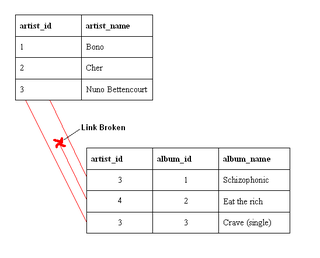
The Mohs scale of mineral hardness is a qualitative ordinal scale characterizing scratch resistance of various minerals through the ability of harder material to scratch softer material. Created in 1812 by German geologist and mineralogist Friedrich Mohs, it is one of several definitions of hardness in materials science, some of which are more quantitative. The method of comparing hardness by observing which minerals can scratch others is of great antiquity, having been mentioned by Theophrastus in his treatise On Stones, c. 300 BC, followed by Pliny the Elder in his Naturalis Historia, c. 77 AD. While greatly facilitating the identification of minerals in the field, the Mohs scale does not show how well hard materials perform in an industrial setting.
Data integrity is the maintenance of, and the assurance of the accuracy and consistency of, data over its entire life-cycle, and is a critical aspect to the design, implementation and usage of any system which stores, processes, or retrieves data. The term is broad in scope and may have widely different meanings depending on the specific context – even under the same general umbrella of computing. It is at times used as a proxy term for data quality, while data validation is a pre-requisite for data integrity. Data integrity is the opposite of data corruption. The overall intent of any data integrity technique is the same: ensure data is recorded exactly as intended and upon later retrieval, ensure the data is the same as it was when it was originally recorded. In short, data integrity aims to prevent unintentional changes to information. Data integrity is not to be confused with data security, the discipline of protecting data from unauthorized parties.
Integrity is the practice of being honest and showing a consistent and uncompromising adherence to strong moral and ethical principles and values. In ethics, integrity is regarded as the honesty and truthfulness or accuracy of one's actions. Integrity can stand in opposition to hypocrisy, in that judging with the standards of integrity involves regarding internal consistency as a virtue, and suggests that parties holding within themselves apparently conflicting values should account for the discrepancy or alter their beliefs. The word integrity evolved from the Latin adjective integer, meaning whole or complete. In this context, integrity is the inner sense of "wholeness" deriving from qualities such as honesty and consistency of character. As such, one may judge that others "have integrity" to the extent that they act according to the values, beliefs and principles they claim to hold.
Cytotoxicity is the quality of being toxic to cells. Examples of toxic agents are an immune cell or some types of venom, e.g. from the puff adder or brown recluse spider.

Ethidium bromide is an intercalating agent commonly used as a fluorescent tag in molecular biology laboratories for techniques such as agarose gel electrophoresis. It is commonly abbreviated as EtBr, which is also an abbreviation for bromoethane. To avoid confusion, others have used the abbreviation EthBr. When exposed to ultraviolet light, it will fluoresce with an orange colour, intensifying almost 20-fold after binding to DNA. Under the name homidium, it has been commonly used since the 1950s in veterinary medicine to treat trypanosomiasis in cattle, a disease caused by trypanosomes. The high incidence of antimicrobial resistance makes this treatment impractical in some areas, where the related isometamidium chloride is used instead. Ethidium bromide may be a mutagen, although this depends on the organism exposed and the circumstances of exposure.

Referential integrity is a property of data stating that all of its references are valid. In the context of relational databases, it requires that if a value of one attribute (column) of a relation (table) references a value of another attribute, then the referenced value must exist.
A drug test is a technical analysis of a biological specimen, for example urine, hair, blood, breath, sweat, and/or oral fluid/saliva—to determine the presence or absence of specified parent drugs or their metabolites. Major applications of drug testing include detection of the presence of performance enhancing steroids in sport, employers and parole/probation officers screening for drugs prohibited by law and police officers testing for the presence and concentration of alcohol (ethanol) in the blood commonly referred to as BAC. BAC tests are typically administered via a breathalyzer while urinalysis is used for the vast majority of drug testing in sports and the workplace. Numerous other methods with varying degrees of accuracy, sensitivity, and detection periods exist.

ISO/IEC 9126Software engineering — Product quality was an international standard for the evaluation of software quality. It has been replaced by ISO/IEC 25010:2011.

CADSTAR is a Windows-based electronic design automation (EDA) software tool for designing and creating schematic diagrams and printed circuit boards (PCBs). It provides engineers with a tool for designing simple or complex, multilayer PCBs. CADSTAR spans schematic capture, variant management, placement, automatic and high-speed routing, signal integrity, power integrity, EMC analysis, design rule checks and production of manufacturing data.

A heat sealer is a machine used to seal products, packaging, and other thermoplastic materials using heat. This can be with uniform thermoplastic monolayers or with materials having several layers, at least one being thermoplastic. Heat sealing can join two similar materials together or can join dissimilar materials, one of which has a thermoplastic layer.
Authenticated encryption (AE) and authenticated encryption with associated data (AEAD) are forms of encryption which simultaneously assure the confidentiality and authenticity of data. These attributes are provided under a single, easy to use programming interface.
NCLEX is a nationwide examination for the licensing of nurses in the United States and Canada since 1982 and 2015, respectively. There are two types, the NCLEX-RN and the NCLEX-PN. After graduation from a school of nursing, one takes the NCLEX exam to receive a nursing license. A nursing license gives an individual the permission to practice nursing, granted by the state where they met the requirements.
Security testing is a process intended to reveal flaws in the security mechanisms of an information system that protect data and maintain functionality as intended. Due to the logical limitations of security testing, passing security testing is not an indication that no flaws exist or that the system adequately satisfies the security requirements.
The knee examination, in medicine and physiotherapy, is performed as part of a physical examination, or when a patient presents with knee pain or a history that suggests a pathology of the knee joint.

The commissural fibers or transverse fibers are axons that connect the two hemispheres of the brain. In contrast to commissural fibers, association fibers connect regions within the same hemisphere of the brain, and projection fibers connect each region to other parts of the brain or to the spinal cord.

Circuit integrity refers to the operability of electrical circuits during a fire. It is a form of fire-resistance rating. Circuit integrity is achieved via passive fire protection means, which are subject to stringent listing and approval use and compliance.
A pile is a slender element cast in the ground or driven into it. Since pile construction as well as the final product are mostly invisible, engineers have often questioned their integrity, i.e. their compliance with project drawings and specifications. In fact, experience has shown that in piles of all kinds flaws may occur. The purpose of integrity testing is to discover such flaws before they can cause any damage.

The cervical spinal nerve 8 (C8) is a spinal nerve of the cervical segment.
The honesty or integrity of individuals can be tested via pre-employment screening from employers. Employers may administer personnel selection tests within the scope of background checks that are used to assess the likelihood that employees will engage in dishonest behavior. Integrity tests are administered to assess whether the honesty of the potential candidate is acceptable in respect to theft and counterproductive work behavior. These tests may weigh in on the final personnel decisions.
PTC IntegrityLifecycle Manager is a software system lifecycle management (SSLM) and application lifecycle management (ALM) platform developed by MKS Inc. and was first released in 2001. The software is client/server, with both desktop (java/swing) and web client interfaces. It provides software development organizations with a collaborative environment in which they can manage the end-to-end processes of development, from requirements management, engineering change management, revision control, and build management to test management and software deployment as well as associated reports & metrics.










